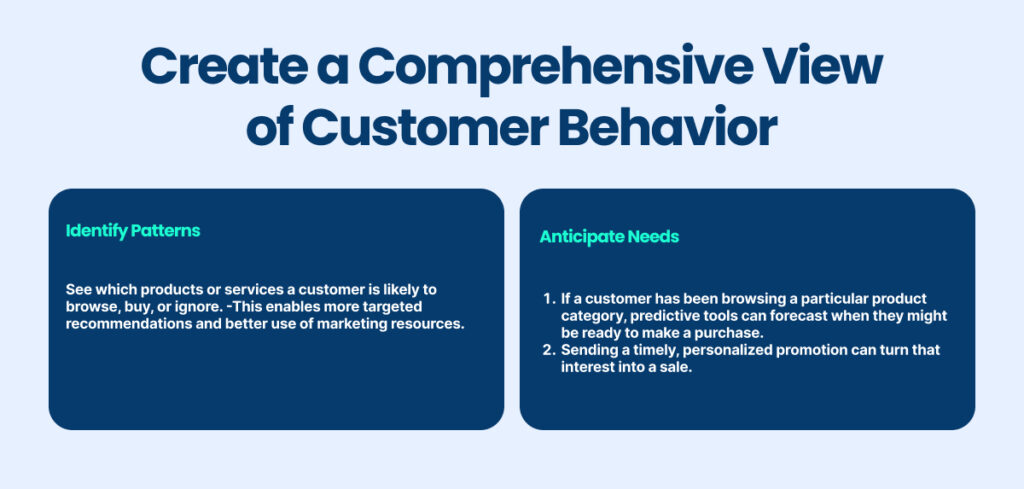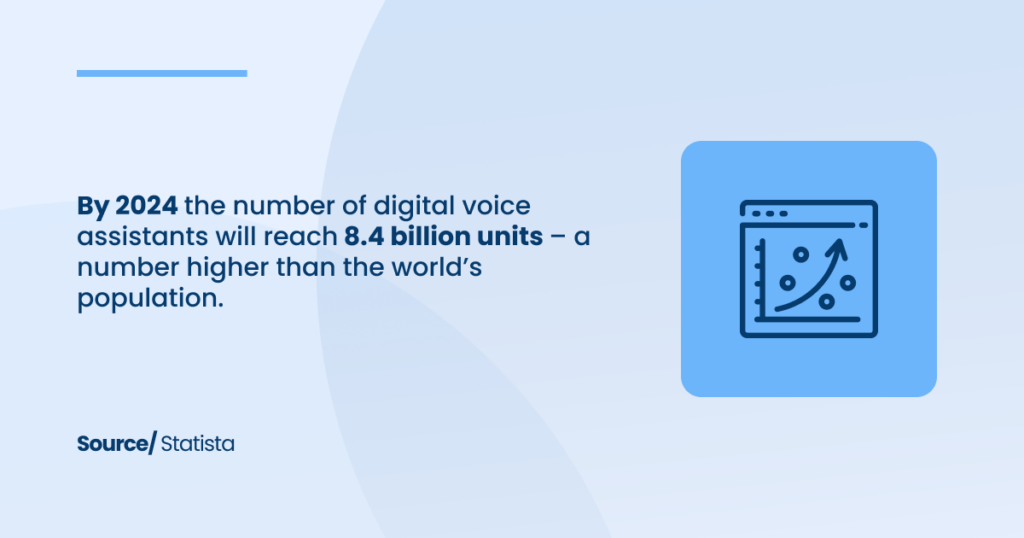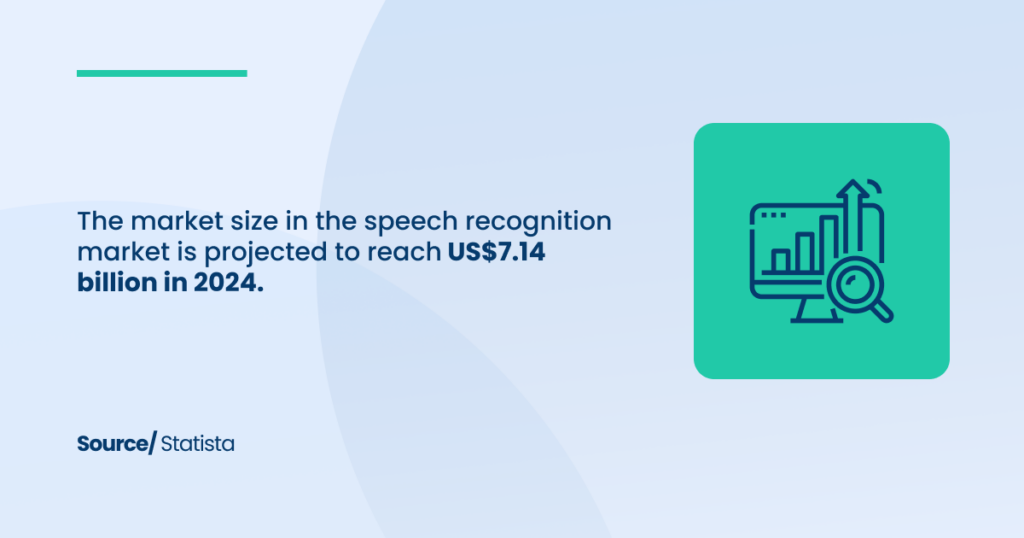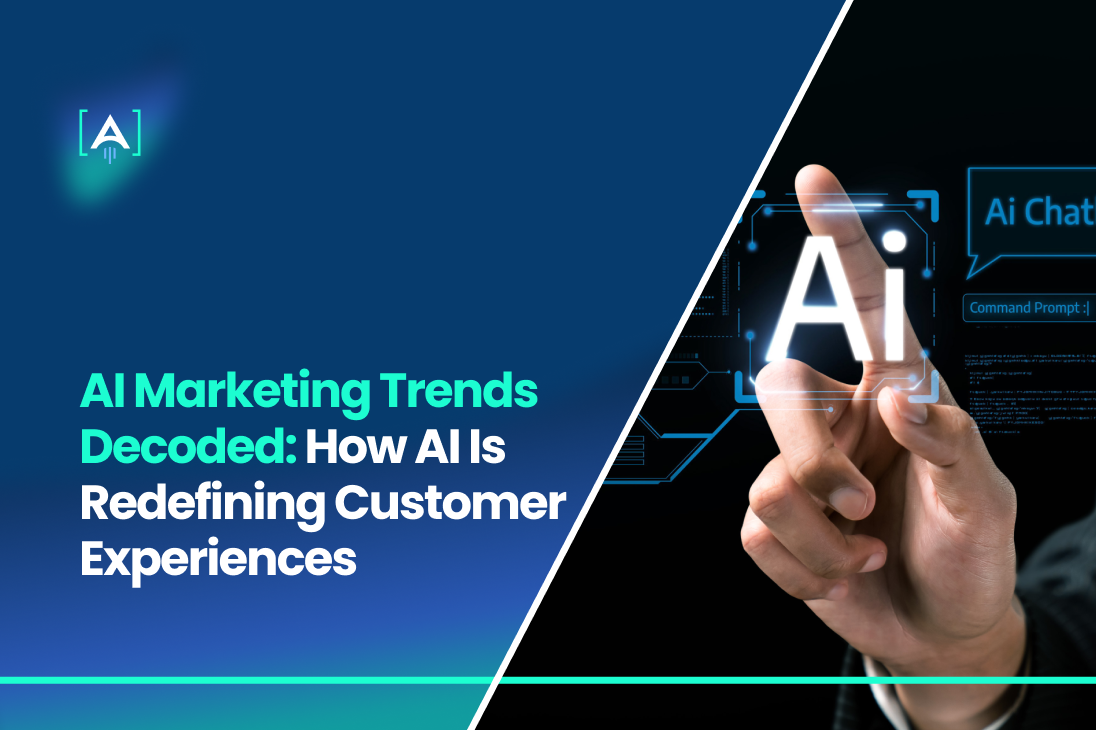Artificial Intelligence isn’t just the future of technology. It’s the future of marketing.
Curious about the next big changes? Yes, AI is here to shake things up.
AI is expected to contribute a significant 21% net increase to the United States GDP by 2030.
Source: Forbes
Although there are concerns surrounding the use of AI, 65% of consumers continue to trust businesses that implement AI technology. This indicates that businesses can sustain consumer trust and leverage AI to enhance customer experiences when they use it responsibly and transparently.
Keep in mind that a reliable AI Marketing Agency can guide you in adopting best practices for ethical AI usage and ensuring responsible implementation.
Let’s explore how AI is transforming the way we connect with customers.
Hyper-Personalized Customer Experiences: How AI Takes It to the Next Level
One of the most impactful shifts is the move toward hyper-personalized customer experiences.
Unlike traditional personalization methods that rely on basic demographic data, AI allows businesses to deliver experiences that feel tailor-made for each individual.
This approach isn’t just a nice-to-have; it’s quickly becoming a must-have for businesses that want to stay ahead in a competitive market.
The Power of Hyper-Personalization with AI
Hyper-personalization uses AI marketing analytics and data-driven insights to craft unique customer journeys.
By leveraging machine learning algorithms and predictive analytics, businesses can understand consumer preferences on a deeper level and respond with highly relevant content and offers.
- Real-Time Adaptation: AI tools analyze customer behavior in real-time, identifying patterns and preferences as users engage with content. Imagine a customer browsing an e-commerce site for hiking boots.
Traditional personalization might suggest related items based on general data, but AI-driven systems can analyze their browsing history and recommend products that match the specific features they’ve been exploring, like waterproof boots or lightweight trail shoes.
- Dynamic Content Recommendations: One of the most impressive trends in AI marketing is the ability to offer dynamic content that adjusts based on user behavior.
Websites and apps powered by AI can change their layout and featured products or services to align with a user’s past interactions. This boosts customer engagement and increases the chances of conversion.
Why Hyper-Personalization Matters for CEOs and Business Owners
For business leaders, the real question is: Why should I care about hyper-personalization?
The answer lies in its potential to directly impact AI ROI and customer retention.
A study by Forbes found that 91% of consumers are more likely to shop with brands that recognize them and provide relevant recommendations. This suggests that businesses that fail to adopt hyper-personalization risk losing their customers to more innovative competitors.
Source: McKinsey&Company
Moreover, hyper-personalization doesn’t just drive sales. It also enhances customer loyalty. When customers feel understood, they’re more likely to return.
And for CEOs focused on sustainable growth, this loyalty is invaluable. Long-term customers contribute more to a company’s profitability than one-time buyers, making hyper-personalization a strategic investment.
The Human Touch in AI-Driven Personalization
While AI makes personalization more powerful, the human element is still crucial.
Business owners should aim to combine AI’s capabilities with their team’s expertise to fine-tune how personalization feels to the customer.
This balance ensures that interactions are personalized without being intrusive, maintaining trust while optimizing the customer experience.
How Predictive Analytics Forecasts Customer Behaviors and Preferences
In the evolving world of AI marketing trends, one tool stands out for its game-changing potential—predictive analytics.
This technology allows businesses to look beyond historical data and into the future, forecasting customer behaviors, trends, and preferences.
For CEOs and business owners, understanding how predictive analytics works and how it can be leveraged is essential for staying ahead of the competition.
What Is Predictive Analytics?
Think of predictive analytics as a data-powered crystal ball. By using AI marketing analytics and machine learning, predictive tools analyze past data to identify patterns and predict future actions.
Source: Predictive analytics market revenue worldwide in 2020 and 2028, Statista
This means your business can make informed decisions, anticipate customer needs, and optimize marketing strategies in real time.
The result? Better customer engagement, higher satisfaction, and an AI content strategy that truly resonates.
Why Business Leaders Should Care
For business owners and CEOs, the value of predictive analytics is clear: it shifts your approach from reactive to proactive.
Instead of responding to market changes after they happen, you can anticipate trends and adapt before your competitors do. This approach not only enhances your strategic planning but also boosts ROI.
Businesses that use predictive analytics see, on average, a 20% increase in marketing campaign effectiveness, according to Garter.
But how does this translate into tangible benefits for your business? Let’s break down how predictive analytics can elevate your customer engagement strategy.
Mapping Customer Journeys: A Game of Anticipation
Example: Imagine a customer who frequently browses outdoor gear.
Predictive analytics can identify seasonal patterns and suggest that the customer might be looking for hiking boots as spring approaches. An AI-driven email campaign offering a special deal on hiking gear can tip the scales in your favor.

From Data to Insights: The Magic of Real-Time Sentiment Analysis
Imagine launching a new product or campaign and getting immediate, honest feedback from your customers.
In the past, this would mean waiting weeks, combing through surveys, or deciphering feedback from different sources.
But with trends in AI marketing, real-time sentiment analysis makes it possible to gauge what your customers feel at the exact moment they interact with your brand.
This immediate insight can change the game for how CEOs and business leaders strategize, pivot, and engage with their audience.
Why Real-Time Sentiment Analysis Matters
For business owners and CEOs, understanding customer sentiment as it unfolds is crucial. This is more than just knowing if feedback is positive or negative; it’s about understanding the nuances and emotions behind the words.
Source: Fortune Business Insights
Real-time sentiment analysis, driven by AI marketing trends, processes huge amounts of customer feedback from multiple sources like social media, reviews, and emails—instantly and accurately.
With this tool, you can:
- Spot customer sentiment shifts early: Recognize if excitement over a new product is fading or if a campaign is missing the mark.
- Act promptly: Address issues as they happen and build trust by showing customers you’re listening.
How AI Transforms Data into Actionable Insights
The real magic lies in how AI can take unstructured data and transform it into understandable insights. Imagine hundreds of comments flooding in, each with its own tone, sentiment, and context.
AI uses Natural Language Processing (NLP) to analyze each piece, identifying not just positive or negative emotions but subtle cues like sarcasm or disappointment.
- Immediate Emotion Tracking: AI tools can sort through thousands of customer comments, determining the overall sentiment with precision. Whether it’s excitement, frustration, or indifference, these insights are invaluable for quick decision-making.
- Deep Learning Capabilities: Beyond simple word recognition, AI understands context. If a customer writes, “I can’t believe how great this product is!” AI recognizes this as positive, while “I can’t believe this product is good” would be flagged differently.
Example: Your company launches a new service. Within hours, feedback comes in. While most comments are positive, AI spots a growing negative trend about one specific feature.
Your team can then act swiftly, perhaps by issuing a statement or tweaking the feature, preventing the issue from growing.
AI-Driven Chatbots and Virtual Assistants: The Secret to 24/7 Customer Engagement
Picture this: a potential customer visits your website at 3 AM with a question about your services. There’s no one available to answer, so they leave, potentially going to your competitor. This is where AI marketing trends are changing the game.
AI-driven chatbots and virtual assistants offer a solution that’s not only efficient but crucial in today’s fast-paced, digital-first world.

For business owners and CEOs looking to maintain seamless, around-the-clock customer service, these tools are nothing short of transformative.
The Power of Always-On Customer Engagement
In the age of instant gratification, customers expect swift responses, regardless of the time of day.
Trends in AI marketing have shown that businesses leveraging AI-powered chatbots and virtual assistants meet these expectations by providing immediate, 24/7 customer engagement. But what makes these tools so effective?
- Immediate Response Time: Unlike human agents, AI-driven chatbots don’t sleep or take breaks. They’re programmed to provide instant replies, handling multiple queries at once without compromising speed or accuracy. This ensures that potential customers aren’t left waiting and are more likely to engage positively with your brand.
- Cost-Efficient Solution: Instead of hiring an extensive customer service team to cover all hours, businesses can use AI chatbots to handle routine queries, saving on labor costs and resources.
A Boost for Your Brand Image
Adopting AI-driven chatbots and virtual assistants positions your business as forward-thinking and customer-centric. For CEOs aiming to strengthen their brand’s reputation, these tools signal innovation and commitment to quality service.
- Scalable Solution: Unlike human teams, which require hiring and training, AI chatbots can be scaled effortlessly to meet growing demand, especially during peak seasons or unexpected surges in activity.
- Consistent Experience: AI ensures that customer interactions remain consistent, delivering uniform service quality no matter how busy things get.
This type of consistency reassures customers that they can rely on your brand, even during high-traffic periods.
It also helps maintain a high standard of customer care, as AI chatbots don’t experience fatigue or burnout.
Voice and Visual AI: The Next Frontier in Customer Interaction
Imagine a world where your business can connect with customers in the most natural and engaging ways possible. Voice and visual AI are transforming this vision into reality, setting new benchmarks for how businesses interact with their customers.

For business owners and CEOs aiming to stay ahead of AI marketing trends, understanding the potential of these technologies is critical.
The Power of Voice AI: More Than Just Smart Speakers
Voice AI has moved far beyond the realm of smart speakers and virtual home assistants. Today, businesses are harnessing the capabilities of voice technology to create seamless and personalized customer experiences.
But what makes voice AI so impactful?
- Natural Interaction: Voice technology enables customers to interact with your brand using their most instinctive communication tool—their voice. This removes barriers and makes interactions faster and more fluid. Whether customers are making a purchase, checking order statuses, or asking questions, voice AI responds in real-time with precise, contextual information.
- Increased Accessibility: For business owners, integrating voice AI can expand your reach to include customers who prefer or require audio-based interactions. Voice technology breaks down language and accessibility barriers, offering a more inclusive experience.
How Voice AI Can Elevate Your Customer Strategy
Voice AI is more than just a convenience; it’s a strategic tool that can set your business apart in a competitive landscape. Here’s how:
- Enhanced Customer Support: Voice-based AI assistants can provide 24/7 support for common inquiries, reducing wait times and improving customer satisfaction. This not only saves costs on staffing but also ensures a consistent service level.
- Personalized Voice Interactions: Leveraging customer data, voice AI can tailor responses based on user history and preferences. Imagine a returning customer asking about their last order and the voice AI providing an instant, personalized update. This creates a unique customer experience that fosters loyalty and trust.
Future Trends in Voice and Visual AI
The landscape of trends in AI marketing is always shifting, but voice and visual AI are set to become even more sophisticated. Expect advancements in emotional recognition, where voice AI can detect sentiment and adjust responses accordingly.
Visual AI will likely integrate more deeply with AR and VR technologies, making online shopping and customer service more immersive than ever.
The Bottom Line: Voice and visual AI are not just tech fads; they’re powerful tools redefining how businesses interact with customers. Embracing these trends can elevate your brand, create a more engaging customer journey, and ultimately lead to greater business success.
For business owners looking to stay competitive, investing in voice and visual AI is a move that promises significant returns in customer engagement and brand loyalty.
Key Takeaways: The Key to Future-Proofing Your Business Strategy
| Section | Key Points to Include | Ideas for Supporting Data/Statistics | Recommended Tips for CEOs/Business Owners |
| Introduction | – Emphasize AI as a transformative force in marketing and customer experience. | – Mention AI’s expected 21% net GDP increase in the U.S. by 2030 (Forbes). | – Highlight the necessity of staying informed on AI marketing trends for future competitiveness. |
| Hyper-Personalized Experiences | – Explain how AI enables businesses to craft tailored experiences based on deeper data insights and real-time interactions. | – Use Forbes’ statistic: 91% of consumers prefer brands that offer relevant recommendations. | – Encourage CEOs to invest in AI marketing analytics to enhance customer retention and loyalty. |
| The Power of Predictive Analytics | – Describe how predictive analytics helps forecast customer behaviors, trends, and preferences, moving from reactive to proactive strategies. | – Mention the average 20% increase in marketing effectiveness from using predictive analytics (Gartner). | – Suggest CEOs use predictive tools to anticipate market changes and adjust strategies preemptively. |
| Real-Time Sentiment Analysis | – Show how AI analyzes feedback instantly to assess customer sentiment and enables agile marketing adjustments. | – Include data on customer trust: 65% of consumers trust businesses using AI responsibly (Fortune Business Insights). | – Recommend using sentiment analysis to detect early signs of customer dissatisfaction and pivot fast. |
| AI-Driven Chatbots & Virtual Assistants | – Highlight 24/7 customer support, cost savings, and enhanced customer satisfaction through consistent service delivery. | – Note: 68% of customers prefer AI-based instant responses (G2). | – CEOs should leverage these tools to handle routine inquiries and free up human resources. |
| Voice & Visual AI | – Illustrate how these technologies make customer interactions more natural and immersive, enhancing user experience. | – Mention the expected 55% smart speaker adoption by 2025. | – Integrate voice AI to break language barriers and visual AI for product previews. |
| Future Trends in AI Marketing | – Forecast the integration of emotional recognition and deeper AR/VR applications in marketing. | – Potential future adoption rates of AR/VR in business contexts (add data as needed). | – CEOs should plan for future tech adoption to remain at the forefront of customer experience. |
| Conclusion | – Reinforce that AI is redefining customer interactions and businesses must embrace these trends for growth and loyalty. | – Reiterate the overall benefits in customer engagement and ROI improvements. | – CEOs should partner with reliable AI marketing agencies to guide ethical and effective AI usage. |
Now It’s Time to Take the Action!
Now, you are familiar with the key trends of AI Marketing. What do you need else if not take the action?
[A] Growth Agency is there for you. We know the deep essence of AI and its essential strategies.
We specialize in turning entrepreneurial dreams into reality with effective, tailored growth strategies.
Excellence is our standard. We cultivate a team of ‘A players’ – top-tier talents who bring passion and expertise to every challenge.
Don’t keep it longer.
Let’s Get Started

